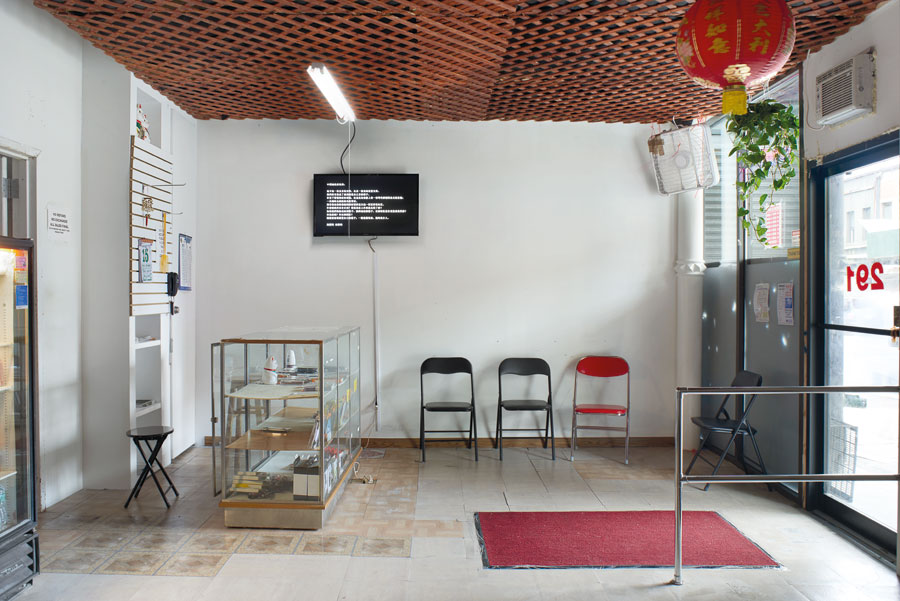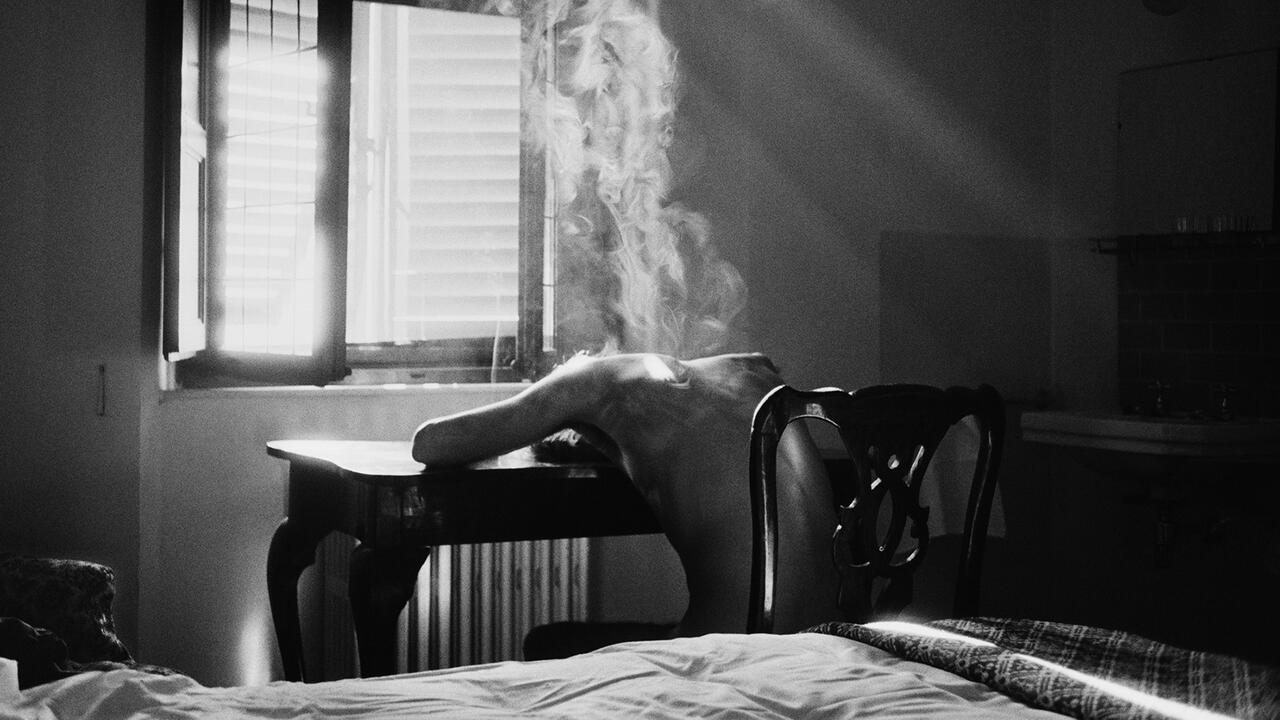Beyond Canal Street: Gentrification in Chinatown
As protests roil the opening of New York's Museum of Chinese Art (MOCA), we revisit the role of artist-led activism in Chinatown
As protests roil the opening of New York's Museum of Chinese Art (MOCA), we revisit the role of artist-led activism in Chinatown

As New York’s Museum of Chinese in America comes under intensified scrutiny for its financial ties to jail expansion plans and gentrification, we revisit this piece from the archive on the struggle to preserve Chinatowns in the US
In October of 2017, a conflict erupted in New York City’s Chinatown over an exhibition at James Cohan Gallery by the Israeli-American artist Omer Fast. For his show, ‘August’, Fast had transformed the gallery – located in the heart of the neighbourhood – into a derelict waiting room of broken ATMs and rickety metal chairs. His intention was to ‘re-create what the space looked like before the gallery moved in almost two years ago’, but the result was a caricature of a dingy Chinatown. Local activists, upset over what they saw as ‘racist art’ and ‘poverty porn’, staged heated protests outside the gallery. The New York Times declared it a ‘serious misfire’ and ‘the kind of fantasy version of immigrant neighbourhoods evoked to justify “slum clearance”’.
Protests over the role of art in gentrification have flared up in cities across the US, as galleries and exhibits become flashpoints in the debate over racial representation and rising housing costs. Spearheading the actions against Fast was the activist art collective Chinatown Art Brigade, which works alongside CAAAV – a grassroots group of low-income Asian tenants fighting evictions and displacement in Chinatown. The Brigade formed in 2015, when a CAAAV member approached artists Tomie Arai, ManSee Kong and Betty Yu about doing an awareness-raising public art project. In recent years, New York has offered incentives to developers to raze old buildings and construct new luxury condos and hotels. Chinatown groups countered the city-led initiative with their own plan to protect affordable housing and small businesses. All three artists signed on. Aided by the Illuminator collective – best known for their ‘99%’ bat-signal during the Occupy Wall Street protests of 2011 – the Brigade projected anti-gentrification mantras in a Chinatown park and activists spoke to curious pedestrians about the need for policies to protect affordable housing and curb the role of capital in community development.
‘Chinatown in New York City is like ground zero for what’s happening in the city and the country,’ said Yu, a filmmaker and interdisciplinary artist, explaining that the neighbourhood is already home to more than 100 galleries and a thriving tourism industry. Chinatown, in other words, has been mostly gentrified for years and, in recent decades, the Chinese population has declined dramatically under the influx of wealthier, white residents.

But in many working-class brown, black and immigrant neighbourhoods around the US, new cafes and galleries have only more recently fomented an epidemic of rising rents, landlord harassment and evictions. Activist groups – many of them allies of the Brigade – have protested these new businesses, from the Brooklyn Anti-Gentrification Network to Los Angeles’s Boyle Heights Alliance Against Artwashing and Displacement, which has become notorious for its confrontational actions against galleries in the working-class Latinx neighbourhood. Meanwhile, many of New York City’s Chinese immigrants have migrated to Flushing, Queens, and Sunset Park, Brooklyn, over the past few decades, where satellite Chinatowns now dwarf Manhattan’s. But even these outer-borough outposts remain vulnerable to the real-estate juggernaut sweeping the city; Sunset Park has faced dramatically rising rents in recent years.
Gentrification in New York is not simply a white invasion: some of the investors behind the new developments are overseas Chinese, as China’s global position has changed dramatically in the last half century. Many Chinatowns across the globe are no longer populated exclusively by poor, struggling immigrants. Some of the most conspicuous are in Africa, where an estimated one million Chinese have migrated in the last two decades to help China secure natural resources, food supplies and new export markets for its goods. Chinese petty traders have cornered the import market in Senegal. Chinese companies in Sierra Leone, Congo and Zambia are capitalizing on newly privatized mining industries. Chinese investors are snapping up farmland in Mali. And, in Namibia’s Oshikango Chinatown, restaurants, hotels and bars have been springing up to service the Chinese community, as the journalist Howard French documented in China’s Second Continent: How a Million Migrants Are Building a New Empire in Africa (2014). Many of these migrants left China due to the limited opportunities at home. Yet, not unlike the first wave of 19th-century Chinese immigrants to arrive in the US, they continue to work in substandard conditions in their new countries. Nonetheless, today’s migrants to Africa arrive in positions of privilege relative to local populations, aptly symbolized by the gated Chinatowns in which most of them live. China is a new imperial power, which exemplifies how, over the past 50 years, global capital has racially diversified and is no longer exclusively Euro-American or white.
And neither is the wealthiest class of Americans. This is apparent in the expanding Asian enclaves of Southern California, including the exclusive suburb of San Marino, where median incomes exceed those of Beverly Hills and the far-right John Birch Society established its Western headquarters in 1959. In 1970, the population was 99.7 percent white. Today, 86.8 percent of its residents were born in East Asia. This is part of a broader demographic shift in the San Gabriel Valley, just 20 minutes east of central Los Angeles. There, the Asian populations in more than half a dozen suburban cities have risen from single digits in the 1980s to become the majority today. Dominated by sprawling strip malls of hot-pot restaurants, mobile-phone gadget shops and bubble tea cafes, their thoroughfares are not the Chinatowns of kitschy red lanterns and knick-knack tourist shops. Rather, these pristine fortresses of beauty, candy and clothing shops, with their bright, gleaming signs, are ringed by parking lots of Japanese cars creeping along the aisles. Next to blue-lit fountains, youths in androgynous K-pop fashion enjoy bubble tea and shaved ice from Taiwanese dessert cafes. With Asians being the fastest-growing ethnic group in the US, these neighbourhoods are now home to some of the country’s largest, majority-Asian enclaves.
Yet, this vast demographic group is far from uniform. While many in the San Gabriel Valley live below the poverty line, just a few hours away in Silicon Valley, where Twitter’s technical workforce is 34 percent Asian, skyrocketing rents have created a major homelessness crisis among the Latinx residents. Between Silicon Valley and Manhattan’s Chinatown – where poor Asian immigrants are still being evicted and displaced – are white hipsters really the lowest common denominator? Trendy cafes, bars and galleries may be harbingers of gentrification, but only because global capital – the real-estate developers, the governments incentivizing their ‘urban revitalization’ projects and the banks that fund them – presume their customers can also pay higher rents. And, in the absence of strong affordable housing measures and restrictions on investor-driven development, capital is able to manifest its destabilizing vision in these neighbourhoods.
While capital is racially diversifying, asset-based wealth remains disproportionately concentrated in the hands of white Americans. Fast may have intended to meditate on the transformation of Chinatown but, lacking any reflection on the forces driving gentrification – including institutions like his gallery – he simply reproduced the images that capital deploys to justify evicting poor tenants, razing old buildings and replacing them with luxury developments. His tone-deafness was so blatant that it may as well have been a performance.
Little wonder, then, that Chinatown Art Brigade sought to counter his performance with an even louder one: protest. In a society of spectacle, where images drive political decisions as often as facts, the war over how entire communities are represented can have real policy consequences for urban development. But protest and performance, limited as they are to a moment in time and a singular act, are ill-suited for building a movement capable of challenging the powerful network of banks, developers, real-estate management and holding companies, government officials and lobbyists that constitute capital today. They are also ill-suited for building the long-lasting alliances across race and class – between Chinese and Latinx immigrants, or between different groups of Asians and Asian Americans – that are the work of organizing and forging independent political institutions.
‘We’re just doing the work with the goal of “tenants first, organizing first”. We exist to serve and support that in a creative culture,’ said Yu. ‘We’ve had culture here in Chinatown for many decades. It’s not really up to the wealthy artistic elite to say: “This is a new art scene.”’
Main Image: Chinatown Art Brigade, Here to Stay, 2016, community art project in Chinatown, New York. Courtesy: the artists; photograph: KahEan Chang © Chinatown Art Brigade, 2017























